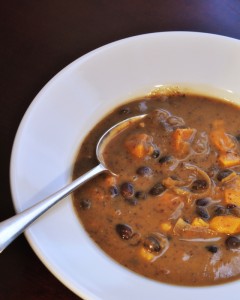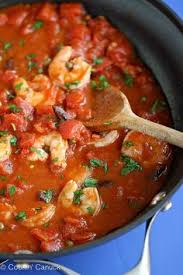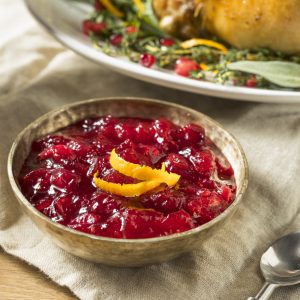
Sweet Homemade Cranberry Sauce for Thanksgiving Dinner
Cranberry Sauce with Clementine + Ginger
Makes 2 cups
2 clementines, 1 zested and both peeled, sectioned, and cut into 3 pieces each
2 cups fresh or frozen cranberries
1/3 cup sugar
1 tablespoon finely grated and minced fresh ginger
Pinch of salt
In a medium saucepan, combine the clementine zest and pieces, cranberries, sugar, ginger, and salt. Bring the mixture to a simmer over medium-high heat, then reduce heat to low and cook, partially covered, until thickened and bubbly, about 10 minutes. Stir vigorously to break up the cranberries. Allow to cool to room temperature before serving. Serve or chill for up to 2 weeks in the refrigerator.
Mashed Potatoes and Celery Root with Melted Leeks
Serves 6 to 8
This is a slam-dunk recipe for Thanksgiving. Only slightly more involved than regular mashed potatoes, but people will go nuts when they take a bite. The celery root and creamed leeks blend right in with the potatoes, so the first bite is a wild surprise of flavor.
If you find yourself with leftovers, make soup. Just thin with enough chicken stock (and a dash of cream) to achieve the right consistency.
6 large russet potatoes (about 3 pounds), peeled and cut in 2-inch pieces
1 large celery root, peeled and cut in 2-inch pieces
4 large leeks, white and pale-green parts, sliced thin
4 tablespoons unsalted butter
1/2 cup half-and-half or heavy cream
Coarse salt and freshly ground pepper
- In a large pot, cover the potatoes and celery root with 2 inches of water, and bring to a boil over medium-high heat. Reduce heat to medium, cover, and cook until the vegetables are tender, about 20 minutes.
- Meanwhile, in a large skillet, heat the butter over medium heat. Add leeks, and reduce heat to medium-low. Slowly cook leeks until they are almost melting, about 20 minutes, covering them with a lid if they begin to brown instead of soften. Remove from heat, and transfer to a food processor with the cream. Process until very smooth.
- When the potatoes are ready, drain them, reserving 1 cup of the cooking liquid. Mash the potatoes, adding about ¼ cup of the cooking liquid or more as needed, until relatively smooth. Stir in the leek purée. Season with salt and pepper, adding a bit of reserved cooking liquid if the potatoes are too dry. Serve hot.
Golden Turmeric Chicken
Serves 4
This chicken recipe uses both fresh and dried turmeric to boost its flavor, color, and overall healthfulness. To highlight its brilliant color, a bit of heavy cream is added to the simmer sauce so the whole dish is bathed in a yellow glow. This sauce is so good you’ll want to be sure to serve it alongside a heap of fluffy jasmine or basmati rice, so not a drop is left behind.
2 tablespoons unsalted butter
1 medium yellow onion, thinly sliced
1 tablespoon peeled and minced fresh turmeric root
Kosher salt and freshly ground black pepper
1 1/2 pounds boneless, skinless chicken thighs
1 1/2 teaspoons ground turmeric
1/2 cup white wine
1/2 cup heavy cream
1/2 cup chicken broth
Cooked basmati or jasmine rice, for serving
Chopped fresh cilantro leaves and tender stems, for garnish
- Melt the butter in a 12-inch or larger skillet over medium heat. Add the onion, fresh turmeric, pepper, and 1/2 teaspoon of the salt. Cook, stirring occasionally, until the onions are softened, about 5 minutes. Meanwhile, place the chicken on a large plate with the smooth-top side facing up. Season with salt and all of the ground turmeric.
- Push the onions to the outer edges of the pan and place the chicken, seasoned-side down, in a single layer in the middle of the pan. Season the chicken with more salt. Cook, undisturbed, until the chicken just begins to brown, no longer than 3 to 4 minutes (any longer and the turmeric will start to burn).
- Using tongs, flip the chicken and cook for 2 minutes more. Pour in the wine and use a wooden spoon to scrape the browned bits from the bottom of the pan. Cook for 1 minute, pour in the cream and broth, and stir gently to combine.
- Reduce heat to medium-low, cover, and cook until the chicken is tender and cooked through, and registers at least 165°F on an instant-read thermometer, 18 to 22 minutes. Serve over rice and garnish with cilantro.
- If this sort of flavorful, one-dish cooking style appeals to you, then you are a candidate for our Quick + Ridiculously Delicious Dinners class.
Smoky Black Bean and Sweet Potato Soup
Serves 8
Smoked paprika, black beans, and sweet potatoes are a marvelous trio. And nothing is more comforting than a 30 minutes-to-prepare black bean soup, made from primarily pantry staples. Make lots: Leftovers can be frozen for the next time you want a comforting bowl of soup.
2 tablespoons extra virgin olive oil
1 medium onion, coarsely chopped
4 large cloves garlic, roughly chopped
2 stalks celery, roughly chopped
1 tablespoon smoked paprika or 1 chipotle pepper in adobo (will make soup very spicy)
1 tablespoon ground cumin
Dash of cayenne pepper (not if using chipotle pepper)
1 14-ounce can diced tomatoes
2 large sweet potatoes, peeled, and cut in 1/2 inch cubes (you can also sub butternut squash cubes)
3 15-ounce cans black beans, drained (not rinsed)
1 quart vegetable or chicken broth
Coarse salt
Fresh lime juice, as needed
Sour cream or Greek yogurt, for serving
In a large, heavy soup pot, heat the oil over medium-high heat. Add the onions, garlic, and celery, and cook until translucent, about 5 minutes. Add spices (or chipotle) and cook until fragrant, about 1 minute. Stir in the tomatoes, squash, and beans and enough broth to just cover the beans with liquid. Bring the mixture to a boil, reduce heat to low, and simmer, covered, until the squash is tender, about 20 minutes. Transfer one-quarter of the soup to a food processor or blender and puree until smooth (be careful not the fill the blender more than halfway full, because the hot soup may explode out the top…place a kitchen towel over the lid before pureeing to be on the safe side!). Stir the puree back into the soup and season with salt and lime juice. Serve hot with sour cream or Greek yogurt, as desired.
- From our Winter Soups class.
 Indian Butter-Braised Vegetables (Cabbage Poriyal)
Indian Butter-Braised Vegetables (Cabbage Poriyal)
Serves 6
A Southern Indian one-pan vegetable dish that offers an easy way to experiment with Indian spices and cooking techniques. Serve as a main course with rice, or as a side dish to roasted chicken, pork chops, or sauteed shrimp.
2 tablespoons unsalted butter or extra-virgin olive oil
1 tablespoon finely minced fresh ginger
2 teaspoons black mustard seeds
1 teaspoon cumin seeds
2 teaspoons split red lentils (optional)
1/4 teaspoon cayenne pepper
2 teaspoons ground coriander
1 teaspoon turmeric
1 small onion, thinly sliced
1 small cabbage (or 1/2 large), cored and sliced thin
1 teaspoon kosher salt, plus more to taste
3 tablespoons unsweetened shredded coconut
1 cup frozen peas, thawed (or not)
1/2 cup whole milk yogurt OR 1 tablespoon fresh lemon juice
Heat the oil over medium heat in a large skillet. Add the mustard seeds, cumin seeds, and lentils. Cook for 1 minute, or until the mustard seeds start to pop. Add the chiles or cayenne, coriander and turmeric and cook for 30 seconds more. Add the onion and cook, stirring, until it begins to soften, about 3 minutes. Add the cabbage and ½ cup water, cover, reduce heat to low, and cook until softened, about 10 minutes. Uncover add the salt, coconut, peas and yogurt or lemon juice, and cook for another minute, until heated through. Season to taste with more salt and more acidifiers, as needed to brighten the flavors.
- If you like this recipe, join us for more great recipes at our Introduction to Indian Cooking class.
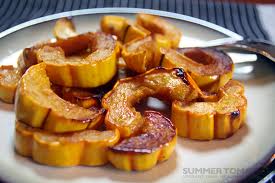 Curry-Roasted Delicata Squash
Curry-Roasted Delicata Squash
Serves 4
Delicata are beautiful, oblong winter squash that appear in the markets in the fall. They are all the more special because they only show up seasonally (whereas you can find acorn and butternut squash year-round). They have a bright orange flesh and green-and-orange-striped skin; the sweetest ones have more orange than green. Best of all, their skin is edible, so no peeling is required! The roasted skin offers a perfect counterpoint to the buttery soft flesh. Smoked paprika is another great spice pairing with delicata; just substitute it for the curry in this recipe when you want a smoky treat.
2 large delicata squash, cut in half lengthwise and seeds removed with a spoon
3 tablespoons extra-virgin olive oil
Kosher salt and freshly ground black pepper
2 teaspoons curry powder
- Preheat the oven to 375°. Cut the squash into ½-inch half-moons.
- In a large mixing bowl, toss the squash with oil, 1 teaspoon salt, a few grindings of pepper, and the curry powder. Transfer to a rimmed baking sheet and spread out in a single layer for even browning.
- Roast until the squash is tender and the undersides are golden brown, about 30 minutes. Let the squash rest for 5 minutes on the baking sheet before removing with a thin spatula. This gives them a chance to steam themselves off the pan’s surface, so you don’t leave any of their sweet crust behind.
- Serve warm or at room temperature. This squash is also delicious eaten cold straight from the fridge, as a snack.
- From our Vegan Suppers for Everyone class.
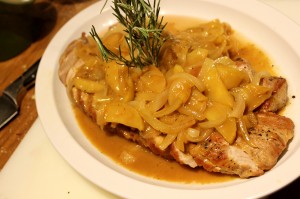 Roasted Pork Tenderloin with Bacon-Apple Cider Pan Gravy
Roasted Pork Tenderloin with Bacon-Apple Cider Pan Gravy
Serves 4
Pork tenderloin, bacon, apples. These are reason enough to make this recipe. You really can’t improve upon this trifecta of goodness
4 strips bacon (or substitute 3 tablespoons extra virgin olive oil)
2 pork tenderloins (about ¾ pound each)
Kosher salt and freshly ground black pepper
1 medium onion, thinly sliced
2 apples, peeled and thinly sliced
2 tablespoons all-purpose flour
2/3 cup apple cider
1 1/3 cups chicken broth
1 sprig fresh rosemary
1 tablespoon apple cider vinegar or red wine vinegar
- Add the bacon to a large sauté pan over medium high heat. Cook until it renders its fat and crisps, about 8 minutes, turning as needed. Transfer the bacon to a paper towel−lined plate and pour off (and save) all but 2 tablespoons of the fat from the pan.
- Season the tenderloins with salt and pepper on one side only and add them to the hot pan, seasoned side down. Season the other side with salt and pepper. Cook until browned on both sides, about 8 minutes total. Transfer the tenderloins to another plate.
- Make the gravy: Add 2 tablespoons of the reserved bacon fat to the pan and add the onion, apple, and a generous sprinkle of salt, cooking until the apples are lightly browned, about 5 minutes. Sprinkle the flour over the apples and cook, stirring, until the flour disappears (is absorbed by the oil). Add the cider, broth, vinegar, and thyme. Bring to a boil, scraping the browned-on bits (fond) off the bottom of the pan to incorporate it into the gravy.
- Return the tenderloins to the pan along with any accumulated juices. Return to a boil, reduce heat to medium-low, cover, and cook until the pork registers 145° on an instant-read thermometer, 6 to 10 minutes, depending on the thickness of the tenderloin.
- Transfer the pork to a cutting board with a well and let rest for 5 minutes. Remove the thyme sprig and taste the gravy, seasoning it with salt and more vinegar, as needed, to make it taste bright.
- Slice the tenderloin 1 inch thick and serve with the rich gravy and crumbled reserved bacon on top (and don’t fret if your bacon mysteriously disappears before the dish is finished: cook’s treat).
From our Pork Lovers Workshop.
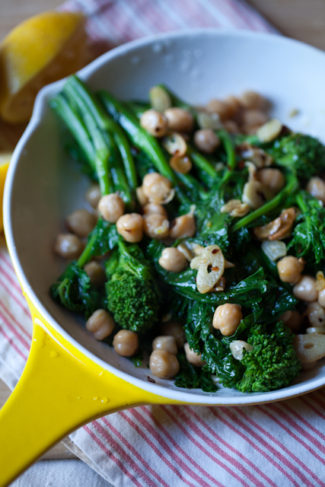 Garlicky Broccoli Rabe with Chickpeas
Garlicky Broccoli Rabe with Chickpeas
Serves 4
This is how you make delicious broccoli rabe. One trick is to squeeze as much water out of the blanched rabe as possible to concentrate its flavor. The other is to season it with just enough garlic, hot pepper flakes, and salty Parmesan cheese. And we strongly encourage you use “real” Parmesan cheese, called Parmigiano-Reggiano, which is from Italy and aged over 2 years. Its flavor cannot be duplicated.
Kosher salt
1 bunch broccoli rabe, bottom 3 inches of stalk discarded
4 tablespoons extra-virgin olive oil
3 garlic cloves, minced
1/4 teaspoon crushed red-pepper flakes
2 tablespoons chicken broth or water, as needed
Parmigiano-Reggiano cheese, for serving
1 15-ounce can chickpeas, drained but not rinsed
- Bring a large pot of salty water (1 tablespoon of salt per 6 cups water) to a boil over high heat. Using tongs, add the broccoli rabe to the boiling water and submerge below the water line. Cook until bright green and crisp tender, testing for doneness after 2 minutes. Remove with tongs or drain into a colander set in the sink. Run under cold water until they are cool to the touch, to stop them from cooking and set their vivid color.
- Take 3 blanched stalks and firmly squeeze them over the sink to remove as much water from the stalks and leaves as you can. Repeat with the rest of the rabe. Cut the stalks into 3-inch pieces, and set aside.
- In a large sauté pan set over medium heat, combine the oil, garlic, and pepper flakes. When the garlic becomes fragrant, about 1 minute, add the chopped broccoli rabe and chickpeas cook until both are warmed through, about 2 minutes, adding a few tablespoons of water if the pan looks dry. Season with salt and a generous grating of Parmigiano cheese. Serve warm or at room temperature.
- From our Northern Italian Classics class.
Roasted Ratatouille
 Serves 6
Serves 6
Ratatouille is a deeply satisfying Southern French dish made by individually cooking 5 different vegetables to perfection. While this creates unbeatable flavor, it also poses a lengthy task for the home cook. This recipe simplifies the steps needed to make a classic ratatouille without sacrificing flavor. The eggplant and zucchini roast and caramelize in the oven while you cook the juicier vegetables together to make a rich base. The addition of briny olives and fresh basil at the end further brighten this traditional dish.
4 Japanese (slim lavender) eggplants, cut into 3/4-inch pieces
2 large zucchini, cut into 3/4-inch half moons
3 tablespoons extra-virgin olive oil, plus more for eggplant
Coarse salt and freshly ground black pepper
4 garlic cloves, smashed and thinly sliced
1 large onion, chopped medium
2 orange or yellow bell peppers, cored and sliced into 3/4-inch squares
1/2 teaspoon fresh thyme leaves
4 large ripe tomatoes, roughly chopped, juices reserved or 1 28-ounce can whole peeled tomatoes
1/3 cup kalamata olives, pitted and cut in quarters or 3 tablespoons capers, drained
1/4 cup fresh basil leaves, thinly sliced
- Preheat the oven to 400°. In a large bowl, toss the eggplant and zucchini with 3 tablespoons of olive oil and season generously with salt. Rub another tablespoon of olive oil on a baking sheet and arrange the eggplant and zucchini cubes in an even layer on the oiled sheet. Roast until golden brown, about 40 minutes. Set aside.
- In a large skillet, heat the oil over medium heat. Add the garlic, onion, peppers, and thyme and cook until the onions are translucent and the pepper softened, about 5 minutes. Add the tomatoes, olives or capers, and cook, partially covered, until the tomatoes break down and the mixture is thickened slightly, about 10 minutes. Remove from the heat and stir in the basil leaves until wilted.
- Stir in the roasted eggplant and zucchini and season to taste with more salt and pepper. Serve warm or at room temperature.
- From our Vegetarian Summer Dinners class
Braised Shrimp Puttanesca
Serves 4
Puttanesca is an extra-flavorful, tomato-based pasta sauce, packed with salty, briny, and pungent ingredients. These same flavors also work wonders with a pound of shrimp. Serve over your favorite pasta shape or creamy polenta.
3 tablespoons extra virgin olive oil
1 small onion, coarsely chopped
3 garlic cloves, crushed and sliced
3 anchovy fillets
½ teaspoon crushed red-pepper flakes, or to taste
1 twenty-eight ounce can whole peeled tomatoes, lightly crushed with your hands
½ cup red wine
3 tablespoons capers
1/3 cup chopped kalamata olives
1 pound large shrimp, peeled and deveined
Kosher salt, as needed
In a large skillet, heat the oil over medium-high heat. Add the onions and garlic and cook until soft and translucent, about 4 minutes. Add the anchovies and pepper flakes, and cook just until anchovies dissolve, about 3 minutes. Add the tomatoes and wine, and cook until the sauce is thickened, about 10 minutes. Nestle the shrimp into the sauce and sprinkle with the capers and olives. Bring the sauce back to a boil, reduce heat to medium-low, and simmer, covered, until the shrimp are cooked through, no more than 4 minutes. Season to taste with salt, if needed (the olives, capers, and anchovies are quite salty).
String Beans with Orange Gremolata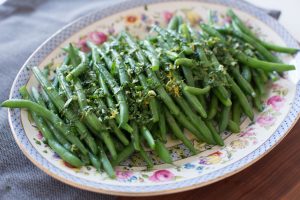
Serves 4
Gremolata is a bright, herbal sprinkle made from fresh parsley, garlic, and citrus zest. Traditionally used to top rich, long-cooked meats to cut their richness, it is also a terrific way to perk up any blanched or roasted vegetables. You can substitute some of the parsley for minced dill or cilantro to vary the flavor. Gremolata is best used on vegetables served at room temperature.
3 tablespoons chopped fresh parsley
1 large clove garlic, very finely minced
Grated zest of 1 orange or lemon, plus juice
1 pound string beans, tough ends removed
2 tablespoons extra-virgin olive oil
Kosher salt
- Bring a large pot of salted water to a boil. Meanwhile, in a small bowl, combine the parsley, garlic, and orange zest, and set aside.
- Add the string beans to the boiling water and blanch until bright green and just tender, about 3 minutes. Remove with tongs and run under cold water to stop the cooking and to set their color (skip this step if serving right away). Blot dry with paper towels, and arrange on a serving platter.
- Drizzle the string beans with the olive oil and then squeeze the citrus juice of 1/2 orange or lemon over the top. Sprinkle over the gremolata mixture and finish with a light dusting of coarse salt. Serve warm or at room temperature.
- Blanching is an excellent cooking method for making crisp-tender green vegetables, like asparagus, string beans, broccoli, broccoli rabe, and snap peas. Wish you knew how to properly cook ALL vegetables? Put our How to Cook Vegetables on your class wish list.



